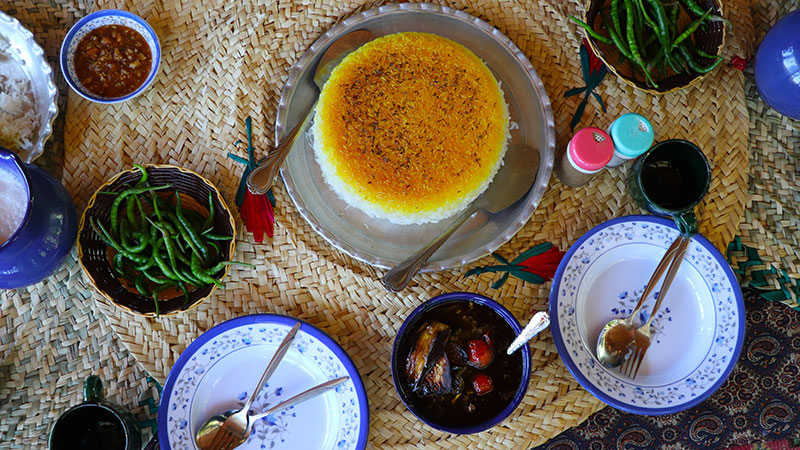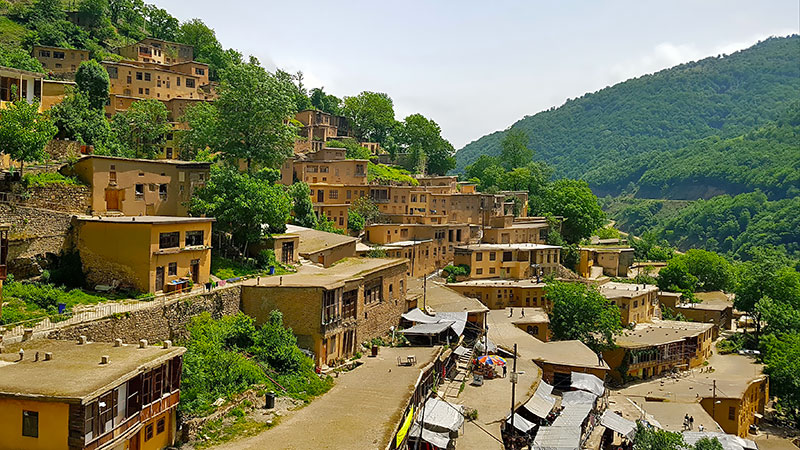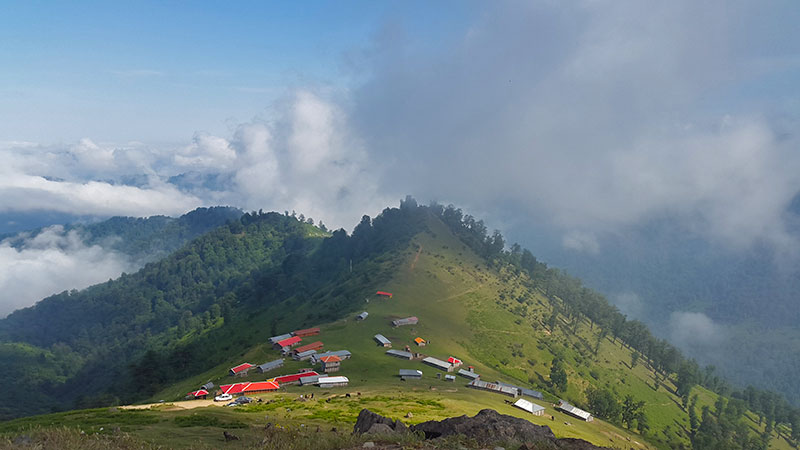 Signin with Google
Signin with Google Signin with Facebook
Signin with Facebook About Iran
About IranTop Things to Do in Gilan

It's one of the most beloved destinations to Iranians: "Shomal", literally "north" mostly designate the province of Gilan and its lush wonders. In summer, many Iranians spend their holidays there, looking for some freshness by the Caspian Sea. While most foreign visitors have in mind the beauties of the Iranian deserts, Gilan Province is home to green forests and a paradise for hikers. The region has one of the most beautiful roads and offers incredible natural and seaside spots.
Rasht, home to the most delicious Gilaki cuisine
Rasht is the capital of the Gilan Province, easily reachable by bus or train from Tehran. It's a perfect base to explore the region and an amazing place to discover the Gilaki cuisine, for which the city is the creative representative according to UNESCO. The main square of Rasht, Shahrdari, display the beautiful city hall, a colonial-style wooden building with a stunning clock on its top. During the night, the area is full of life with street-food sellers everywhere, while during the day, it offers quick access to the buzzing open-air bazaar.

The picturesque village of Masuleh
Masuleh is often considered the most beautiful and scenic village in Iran. Indeed, this small village is a must-see. The millennium-old village is nestled on the mountainside of the Alborz range, with unique architecture: here houses are piled on top of each other in a picturesque way. The houses' roofs thus become streets, where visitors can wander freely in the small alleys full of colourful shops selling local handicrafts. During the cold season, the village and all its ochre-brown houses are wrapped in fog at nightfall, giving the place an incredible and enchanting atmosphere.

Climbing the Rudkhan Castle
Qaleh Rudkhan is a stunning brick and stone castle hidden in the green forests of Gilan, called "jungle". It is located near the small and pretty city of Fuman. It's a popular hiking destination leading to the top of the mountain, at 715 meters, where the remains of this medieval castle stand. Reaching the castle does not go without some effort, as visitors have to climb a long series of stairs, hence its name of "Thousand Step Castle". This is due to the fact that, originally, Rudkhan castle was a military complex built under the Sassanid Dynasty in order to defend the realm against the Arabs invasion. Nowadays, emerging from the high trees and often fog and snow, the castle is covered with lush vegetation and remains one of the best well-preserved fortifications of ancient Iran.
The Gilan Rural Heritage Museum
What surprises the visitors while visiting the Gilan Province, is the unusual architecture of the wooden houses spattered between the rice fields. The architecture of this region is like no other in Iran. This wonderful cultural heritage is highlighted in Gilan Rural Heritage Museum, located in the heart of the Saravan Forest Park. Over 45 hectares, seven villages and typical Gilani cottages have been reconstructed on the site of this open-air museum, in order to introduce the visitor to the different architectural styles and techniques of the region. It is a wonderful insight into the ancestral traditions and cultures of Gilaki people, depicting their traditional lifestyle, from crafts to food and clothes.
Lahijan, the city of Tea
The old town of Lahijian, one of the oldest in the region, is an unmissable destination in Gilan. Located on the slopes of the Alborz Mountains, the city is bordered by the Capsian Sea. Once famous for its silk production, the humid weather of the sea has turned Lahijan into the "city of tea", the main production centre of the tasteful Iranian tea. The Kashef ol-Saltaneh Mausoleum, including the Museum of Tea, is dedicated to the man who introduced tea cultivation there. In the city centre, several small mosques from different eras offer an insight into Lahijan's past, while visitors can appreciate the beautiful Sufi mausoleum, the Sheikh Zahed-e Gilani Mausoleum, and its blue-green pyramidal roof. Aside from the cultural attractions, Lahijan offers plenty of natural places to enjoy. In the east of the city is the Lahijan Pool, an artificial lake with a small island in the middle, reachable by a long bridge. Take the cable car to contemplate the city from Baam-e Sabz, or wander between the tea garden of Satan's Mountain (Sheitan Kuh). Don't miss the rushing waters of the Lahijan Waterfall and the splendid lagoon, a refuge for thousands of migrating birds.
Asalem Road, the stunning road trip
It's one of the most scenic roads of Iran, which goes deep into the northern "jungle" over 70 kilometres. Asalem road is a popular destination, yet far from being crowded, linking the city of Asalem to Khalkhal, in Ardebil Province. It is the promise of an unforgettable road trip in the lush nature of northern Iran. Starting your ride, you are welcomed by a rich and dense flora and fauna, due to the humid weather of the Caspian sea and the high altitude. Every season has its wonders, from the brown leaves of fall to the pristine white snow of winter and the moss-covered tall trees of spring. Every stop offers breathtaking landscapes over valleys wrapped into the clouds. On your way, you can also pause by small villages to enjoy local and fresh food, start a hike or appreciate the benefits of spring waters.

Bandar-e Anzali, a door to the Caspian Sea
The port city of Bandar-e Anzali was the first and biggest port on the southern shores of the Caspian Sea, and nowadays one of the several free-trade zones of Iran. This city, founded in the 19th century, has long been a harbour for trade, famous for its caviar, as 95% of the world's production comes from there. The city-centre offers some interesting glimpses of its past, such as the Russian architecture of some houses, the small Armenian church and the Polish cemetery dating back from the second world war. Bandar-e Anzali is mostly appreciated for its long harbour promenade all along the Sefid Rud, the world's largest freshwater lagoon. The lagoon is heaven for migrating birds and many species of fishes, where it is possible to navigate, on its calm water and between the lotus flowers.
Masal, the village inside the clouds
The county of Masal, in the west of Gilan, is known for its outstanding beauty. Here, nature is the queen and remains untouched. Masal's city is located in the Talesh Mountains, 50 kilometres away from Rasht and is composed of two parts, Masal and Shahderman. Both are full of splendid natural attractions. In this quiet and peaceful environment, visitors come to appreciate the wonders of nature as Masal has numerous waterfalls and many natural caves carved in the heart of the forest. The whole county of Masal is full of green pastures and offers incredible views over valleys drowned into an ocean of clouds. The most spectacular spot to observe such a show is in Olsabelangah village, full of traditional wooden houses and located on top of a hill.

Between the waterfalls and spring waters of Astara
Located at the border with Azerbaijan and surrounded by the Capsian Sea, Astara is an ancient city dating back to the end of the 10th century. Its humid subtropical weather has given birth to a luxuriant nature, which can be best appreciated in the Bibi Yankou Forest Park or in Heyran, where mountains play hide and seek with the clouds. Don't miss the beautiful Laton Waterfall and make sure to have some rest at the Kuteh Kumeh Thermal Spring while visiting Astara. With such lush nature, the surroundings of the city also have rich fauna and flora and is a perfect place to experience birdwatching. Among the historical monuments of Astara are the 2000 years old Shindan Fortress, which was originally a Zoroastrian temple, and the Sufi Mausoleum of Sheikh Taj Al-din, dating back from the Ilkhanid era and considered as a sacred place by the locals.
- Around Gilan-
The Caspian Coastline, from Chaloos to Ramsar
The North of Iran has beautiful seaside to offer to the visitors, all along the Caspian Sea, the world's largest lake. The lush vegetation is proper to the cultivation of rice and tea, whose fields spread at the horizons. The shores calm and quiet waters of the Caspian Sea are a perfect place to walk on the sand and admire the sunset. The best and most scenic spot to enjoy the coast is without a doubt the city of Ramsar, which attracts many visitors. The cable car offers a breathtaking view over the Caspian. The road between Tehran and this coast-city is famous for its exceptional beauty as well as its crowdedness. It crosses the cities of Chaloos and Tonekabon, two of the greenest cities of Mazandaran Province, competing with lush landscapes of wild forests.





